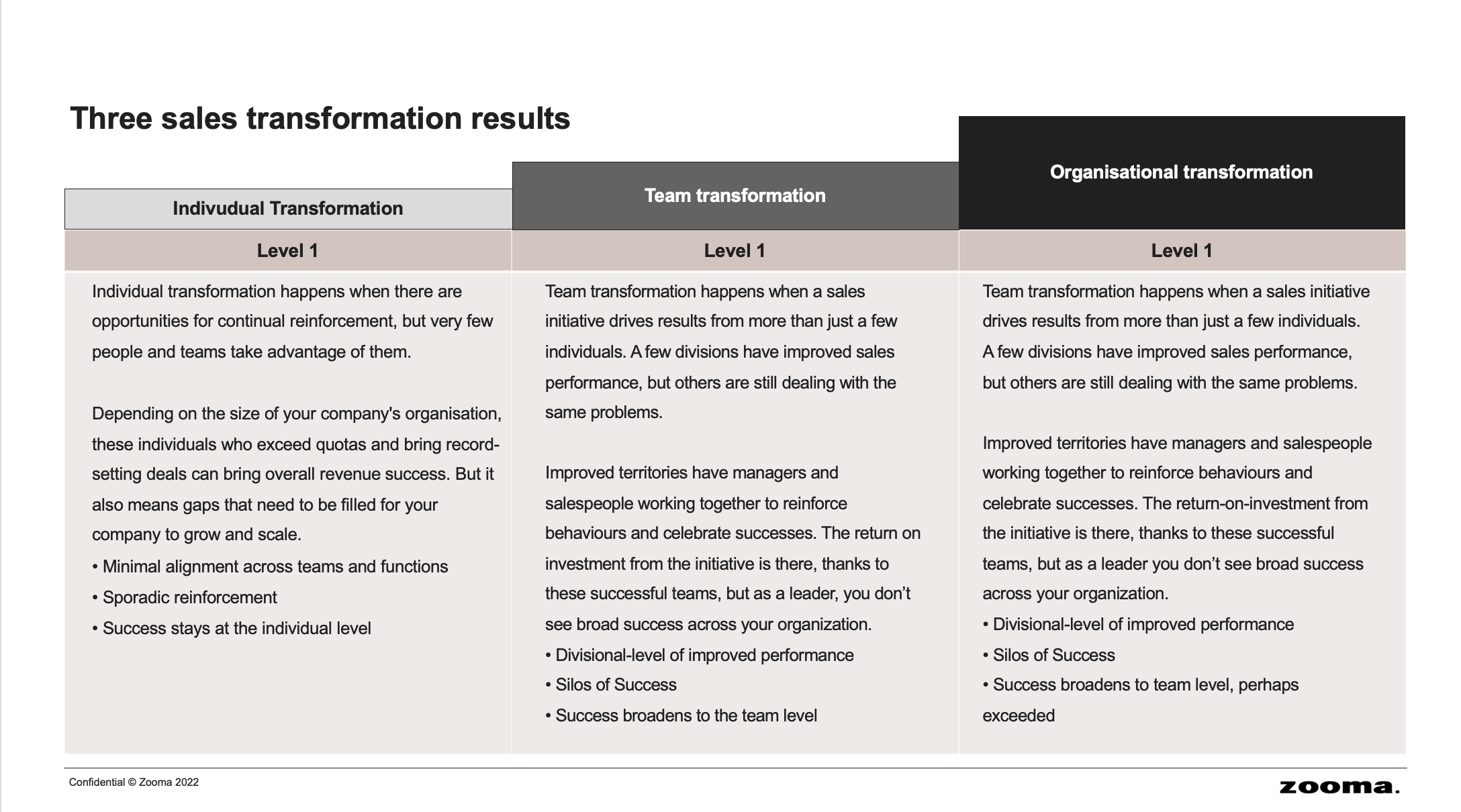- Learn
- The Onlinification Hub
- The three tiers of sales transformation: A comprehensive approach
The three tiers of sales transformation: A comprehensive approach

A total transformation of a company's sales and commercial practices demands time, unwavering dedication, and a dynamic adaptation plan to enhance outcomes. However, an intricately strategised approach, complete with defined initiatives, can foster a transformation that propels growth and paves the way for lucrative exits for emerging businesses. Successful transformation stems from well-synchronised efforts to bolster behavioural changes within the sales team and the organisation.
I've partnered with numerous decision-makers and sales leaders, assisting them in instigating transformational changes that start with the right sales abilities, motivation, and mindset. This has taught me that the definition of success can vary considerably, contingent upon the operationalisation and reinforcement of actions. These differing degrees of effort culminate in three distinct levels of sales and commercial transformation:
Individual transformation
Individual transformation transpires when there's minimal alignment amongst your teams and functions. Opportunities for consistent reinforcement may present themselves but should be more frequently seized upon. Those who seriously engage with large-scale training events garner the rewards of implementing the new sales methodology their company has chosen to adopt.
These individuals appreciate the significance of behaviour modification and are now performing tasks that alter the outcome. Consequently, success is experienced at an individual level. For instance, the sales transformation initiative might change the behaviour of a limited number of sales representatives across your company, empowering these individuals with the mindset, sales skills, and capabilities to boost performance.
As the leadership team, you will perceive success via individual benchmarks. Depending on your company's size, those who exceed quotas and set record-breaking deals can contribute to overall revenue success. Your company may have a few salespeople generating momentum within the sales teams and the organisation, but critical gaps must be addressed to grow and scale in the desired direction.
Team transformation
Team transformation occurs when a sales initiative is driven by more than just a handful of individuals. This results in behavioural changes across entire teams, divisions, or territories.
Certain divisions may have improved sales performance, while others struggle with the same setbacks that previously inhibited success. The divisions showing improvements likely have managers and sales reps collaboratively reinforcing behaviours, enhancing and mentoring new skills, and recognising success. However, these divisions operate in isolation. Consequently, while some teams consistently demonstrate growth and improvement, overall business success could be optimised.
Most leaders discern success through isolated pockets of growth. These successful teams may generate a satisfactory ROI (Return on Investment) from the initiative. However, as a leader, you should aspire to achieve overall success across your entire company. A phased approach to enhancing or evolving the sales methodology may exacerbate your isolated challenges and results. This suggests that your executive leadership must choose between progressing with decreasing success rates or retracing steps to bring the entire company up to par and ready to transition to the next phase.
Organisational transformation
Organisational transformation ensues when your sales organisation instils necessary capabilities within their sales teams, inspires and nurtures cross-functional alignment around target buyers, and establishes a process of continuous reinforcement embraced by the entire company. This results in behaviour changes across your entire sales organisation and supporting departments.
During this transformation, leaders and managers actively utilise resources, lead by example, and hold their colleagues accountable for consistent execution and adoption of the initiative. All other departments interacting with sales and customers (service, marketing, customer success) are synchronised and thoroughly integrated with your company-wide goals and strategies. Reinforcement of changed sales behaviours extends beyond your sales organisation, contributing to the consistency of the new working style. This cross-functional alignment and ongoing support stem from understanding the value of the modified behaviour, process, and approach. The more people who know why they're doing things differently and are committed to achieving the desired results, the better.
In this transformational sales initiative, KPIs are met and often exceeded. Success is observed beyond just the sales team. Your company's executive team recognises additional value in improving the sales approach. Your plans to further invest in building a revenue-driving sales organisation can now be developed and rolled out similarly to scale sales success and increase business value.
How to realise organisational sales transformation
Regardless of the level of transformation, the outcomes from all three tiers are favourable. However, the ultimate aim should be organisational transformation to cultivate resilience within your sales organisation. This is the only method to ensure that the new or evolved sales behaviours persist in a way that aids the company's prosperity and scalability.
Nevertheless, organisational transformation can only come about with widespread behavioural change. For instance, if your transformation aims to increase revenue and achieve stability in the market, it should involve building a resilient salesforce capable of maintaining momentum, adapting to changing buyer needs and performing at an elite level.
The three sales transformation outcomes
I have prepared a PowerPoint presentation detailing these three sales transformation outcomes. Please feel free to adapt it to your PowerPoint template and share it with colleagues, sales teams, and decision-makers to help us talk about implementing new sales behaviours and processes.
If you're on the brink of initiating something new in your sales organisation, this PowerPoint presentation will prove invaluable in helping you establish a new sales initiative.
Keep updated on thoughts, facts and knowledge!
Related
-
By Anders BjörklundWhat is digital sales transformation?
-
By Tobias PasmaFighting churn by removing friction
-
By Anders BjörklundTransforming sales: The road to success and the pitfalls
-
By Anders BjörklundModern lead generation in B2B
-
By Anders BjörklundReimagining the modern B2B salesperson: Key attributes for success
-
By Anders BjörklundIs traditional B2B Sales obsolete?




